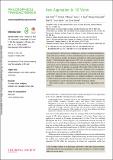Introduction : new approaches to 3D vision
Abstract
New approaches to 3D vision are enabling new advances in artificial intelligence and autonomous vehicles, a better understanding of how animals navigate the 3D world, and new insights into human perception in virtual and augmented reality. Whilst traditional approaches to 3D vision in computer vision (SLAM: simultaneous localization and mapping), animal navigation (cognitive maps), and human vision (optimal cue integration) start from the assumption that the aim of 3D vision is to provide an accurate 3D model of the world, the new approaches to 3D vision explored in this issue challenge this assumption. Instead, they investigate the possibility that computer vision, animal navigation, and human vision can rely on partial or distorted models or no model at all. This issue also highlights the implications for artificial intelligence, autonomous vehicles, human perception in virtual and augmented reality, and the treatment of visual disorders, all of which are explored by individual articles. This article is part of a discussion meeting issue ‘New approaches to 3D vision’.
Citation
Linton , P , Morgan , M J , Read , J C A , Vishwanath , D , Creem-Regehr , S H & Domini , F 2023 , ' Introduction : new approaches to 3D vision ' , Philosophical Transactions of the Royal Society B: Biological Sciences , vol. 378 , no. 1869 , 20210443 . https://doi.org/10.1098/rstb.2021.0443
Publication
Philosophical Transactions of the Royal Society B: Biological Sciences
Status
Peer reviewed
ISSN
0962-8436Type
Journal item
Description
Funding: P.L. is supported by the Presidential Scholars in Society and Neuroscience, Columbia University and a Fellowship in Art, Humanities and Neuroscience at the Italian Academy for Advanced Studies in America, Columbia University. D.V. was supported by a Leverhulme Trust Research Project Grant (grant no. RPG-2016-269: ‘What does it mean to ‘See in 3D’?’). F.D. is supported by a National Science Foundation grant (NSF #BCS 2120610: ‘A test of a novel non-probabilistic model of 3D cue integration’).Collections
Items in the St Andrews Research Repository are protected by copyright, with all rights reserved, unless otherwise indicated.

